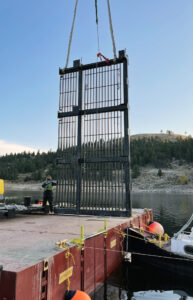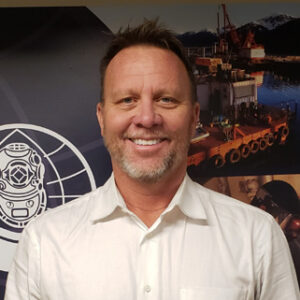Global Diving & Salvage employs world-class, highly skilled divers who perform a wide range of underwater tasks in marine and upland environments, including inspections, salvage operations, marine construction, demolition, and repair. It provides dive systems and teams to work in a wide range of depths, from surface air and mixed gas to saturation diving. Global recently carried out a saturation diving project to replace an underwater trash rack at Denver Water’s Gross Dam. In this interview, Senior Project Manager Michael Rawlings tells us more about the mechanics of saturation diving and how the technique was employed to successfully complete the Gross Dam project.
Hydro Leader: Please tell us about your background, how you came to be a diver, and what led you to the position you are in today.
Michael Rawlings: I started my commercial diving career right after college. I attended a commercial diving school in Long Beach, California, where I received my diving certification. I also had a 100‑ton captain’s license, which is a license required by the U.S. Coast Guard to operate commercial vessels or to take paying passengers on such vessels. With that license and my diving certification, I ran crew boats and rescue boats in the Long Beach area and up and down the West Coast. Eventually, I started my own company, specializing in marina construction for watercraft. I had that business for about 22 years, and ultimately sold it to a large marina construction company. I stayed with them for a couple of years as a project manager. Two years ago, I joined Global as a senior project manager.
Hydro Leader: Please tell us about Global.
Michael Rawlings: Global was founded in 1979 as a family-owned company. A few years ago, it was purchased by Moran Environmental Recovery (MER). MER is an integrated supplier of environmental, industrial, mechanical,
and commercial diving services with an unwavering commitment to industry-leading performance. Global is a leader in the marine services industry with decades of experience managing complex, critical, and technical projects in and around the water. The company is headquartered in Seattle, Washington, with additional offices in Alaska and California. Global is a wholly owned subsidiary of MER, which is based in Massachusetts and has offices along the East Coast and throughout the northeastern United States. Global provides a wide variety of underwater maintenance, repair, installation, and inspection services. In addition to complete project management, we offer engineering support for complex projects that require technical underwater procedures and tooling. Our extensive experience and resources enable us to adapt quickly while always maintaining the highest level of safety and to successfully complete the most complex, challenging assignments.
Hydro Leader: Would you tell us about Gross Dam project that you just completed for Denver Water?
Michael Rawlings: Gross Dam was built in the early 1950s, and part of its design consisted of a giant concrete and steel filter, commonly referred to as a trash rack. This component, located at the foot of the lake side of the dam, prevents debris from entering the primary outlet works. While the existing trash rack was still operationally sound, Denver Water was replacing it to ensure that the structure was fully compliant with today’s seismic regulatory requirements, which have changed since the structure was first built. We were brought in to remove the existing concrete and steel structure and to replace it with a new, custom-built steel trash rack.
Hydro Leader: How difficult is it to dismantle and reconstruct these elements of the dam?
Michael Rawlings: Considering that the work zone is 270 feet below the surface of the lake, this project presented challenges that required us to use saturation diving techniques to get the divers to and from the work site. In addition, the nature of the deep-water environment mandated the use of specialized mechanical methods to remove the existing concrete structure. We had to use a diamond-wire hydraulic saw, among other hydraulic tools, to surgically remove certain sections of the existing trash rack. Some of the existing structure was left behind to be used in conjunction with the new steel structure, but I would say 70 percent of it was removed.
Hydro Leader: What does saturation diving entail?
Michael Rawlings: For deep-water projects, divers must employ a decompression technique known as saturation diving, which means that the diver’s bloodstream is saturated with helium or another suitable gas at the pressure of the surrounding water. Without this saturation, the amount of time a diver could spend in the deep-water environment would be extremely limited and the project would take much longer. Using the saturation technique allows the divers to stay at depth for as long as 30 days, or even longer if necessary. Until the project is complete, the divers remain in a pressurized bell or habitat, located on a floating barge.
Hydro Leader: In the case of the Gross Dam project, how many divers stayed in the saturated environment?
Michael Rawlings: Four divers stayed in the saturated environment throughout the 34‑day project. At any given time, two divers would be working at depth from the diving bell, while the other two rested in the pressurized habitat.
Of the two divers in the bell, one worked in the water, while the other remained in the bell for safety and to support the wet diver. Shifts last 12 hours, with each diver spending 5 hours in the wet environment and the 2 remaining hours to prepare, suit up, and travel between the at-pressure habitat and the underwater work site. When transferring between the habitat and the bell and entering the water, the divers must go through locks. Thus, to get to the work site, they transfer through a lock into a wet bell or into a closed bell. The operation runs continuously, 24 hours a day, for the duration of the project.
Hydro Leader: In addition to the four divers, who else is working on a project like this?
Michael Rawlings: We had 32 people on this job. During each shift, 14 people were on deck supporting the 4 saturated divers at all times. The support team included crane operators, deck foremen, winch operators, welders, saturation diving technicians, lifesaving technicians, and people who specialize in the saturation process as diving bell supervisors.
Hydro Leader: Where and how was the new structure fabricated?

Michael Rawlings: It was built by a steel fabricator in Seattle, Washington. Denver Water provided early design drawings and then Denver Water, the fabricator, and our design team worked together to come up with the final design. We stayed as close to the original design as possible, but we had to modify aspects of it due to certain limitations on what the divers can do underwater. Once we received approval, the fabricator went to work, building it in pieces and coding them so we would know how to piece it all together. Once all the pieces were built, they were shipped from Seattle to Golden, Colorado. At that point, the structure was assembled into larger pieces that were then brought to the site and placed one at a time at the bottom of the lake.
Hydro Leader: Please tell us more about the actual work process.
Michael Rawlings: It is complex, and that is why we have well-trained people and appropriate equipment to ensure that every element of the work happens in a safe and successful manner. In addition to the people, we use cranes, sonar, and remotely operated vehicles to lower the infrastructure into position. Once it’s positioned as close to the installation point as possible, we put the diver back in the water to instruct the dive supervisors and crane operators on how to lift, rotate, spin, or slide the infrastructure into final position. The diver then bolts it in place and repeats the process for the next section until the assembly is complete. Probably 99 percent of our deck crew are divers as well, so they are absolutely committed to carrying out the project properly. Cross-training is important to me. I don’t like to rely on the same four people to go into saturation all the time. Our approach is to try to pair two seasoned divers with two who may have less experience, so that we can eventually bring the latter two up to the same level. On jobs for which saturation is not required, everybody on the barge gets a dive. Giving everyone this exposure ensures that each person has a stake in the project and a commitment to the safety of their colleagues as well as to their own safety.
Hydro Leader: What are the backgrounds of your divers?
Michael Rawlings: Some of them were in the military. A few came in with other marine construction skills and then learned diving. Most of the work they do involves cutting, fabrication, and construction. They do quite a lot of underwater chipping, grinding, and jackhammering concrete. In the offshore world, there is likely more welding than our division engages in.
Hydro Leader: It sounds like both Denver Water and Global are seriously committed to safety. How important is it to your company to have a client with this perspective?
Michael Rawlings: It’s critically important. It makes for a good working relationship. Denver Water understands the limitations to what we can do underwater. We augmented and adapted the work plan to make safety the number 1 goal. We were able to do that because Denver Water shares our commitment to safety.
Hydro Leader: What is your organization’s vision for the future?
Michael Rawlings: We want to continue to be a leader in both offshore and inland diving techniques with an absolute commitment to safety and to keeping our crew healthy and happy. We want to continue to grow; to expand our relationships with our current clients; and, of course, to reach out to new clients. My goal as a senior project manager is to identify new opportunities for work and to conduct it in a successful manner, meeting and exceeding clients’ expectations.
Michael Rawlings is a senior project manager at Global Diving & Salvage. He can be contacted at mrawlings@gdiving.com.


